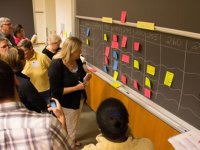How Do I Get a PLN?
What is a PLN?
Will Richardson was the first person to clearly explain to me about six or seven years ago what a PLN was. Back then, PLN stood for Professional, or Personal Learning Network. A better label today, one that might quiet the nitpickers, is Personalized Learning Network -- the shift in nuance maintains that participants are both personal and professional learners. A PLN is a tool that uses social media and technology to collect, communicate, collaborate and create with connected colleagues anywhere at any time. Participating educators, worldwide, make requests and share resources.
Each individual educator becomes a potential source of information. Collecting these sources in a location to access them is the PLN. There are no two PLNs that are the same.
PLNs Develop Thought Leaders
Many early adopters of the PLN have gone on to become thought leaders in education, not surprising given that PLNs seem to promote a great deal of reflection and collaboration. These PLN activities stimulate, for many, the need to express themselves further in blogging, speaking and writing books. Additionally, many established thought leaders develop PLNs to maintain relevancy, following good ideas, rich discussions and resources. PLNs accept people for their ideas, not their titles.
Barriers to Mass Adoption
There are three deterrents to educators using PLNs as a tool for learning and professional development (PD):
- The PLN is a mindset, not the outcome of a workshop or the PD offered annually by many school districts. It is not a one-shot fix.
- Successful users of PLNs overwhelm the uninitiated with techno-babble.
- It requires, at least at first, digital literacy beyond a Google search.
Countless blogs, journals, newspapers, magazine articles and books assert that continuous building and active use of PLNs as a tool for learning benefit educators personally and professionally in ways never before possible. Sadly, all these articles and ballyhoo about connectedness have manifested limited adoption by educators.
We must remember that lifelong learning requires effort. We expect this commitment from students. We should accept no less from ourselves. Fortunately, with a little information (see the linked resources at the end of this post) and an openness to learn, anyone can begin to expand his or her knowledge by using a PLN.
It is with this as the background that Edutopia has asked me to write yet another post on The PLN to which I respond: "Once more unto the breach, dear friends, once more."
PLNs Are Collaboration
Collaboration as a method of learning has been with us from the beginning of education. However, it was mostly limited to face-to-face interactions within school buildings, districts or, in some cases, conferences, if educators were fortunate enough to attend one. This is how teachers connected and collaborated through history. Today, technology is collaboration on steroids, supporting "connected educators" -- a term recognized and celebrated by the U.S. Department of Education.
Some might say that we don't need technology to be connected. I disagree. Technology has fundamentally changed collaboration by removing barriers of time and space.
What Can PLNs Do for You?
Through PLNs, American schoolchildren share cultural information with other children around the world. Teachers exchange methods and strategies. Online discussions and links enable access to materials that would not be revealed otherwise. Resources are accessible and exchanged through networked teachers, not filtered through politicians and corporate monopolies.
Twitter, the social media application, is the backbone for most PLNs. Each 140-character post allows quick and easy transmissions of information to links yielding websites, videos, podcasts, blog posts, articles, interviews and excerpts -- dream resources for classroom professionals. By simply asking, teachers receive content and strategies from sources around the globe.
How to Build a PLN
Spend 20 minutes a day interacting and collaborating. Here's how:
- Start a Twitter account that focuses on following educators.
- Build a circle of connected educators on Google+.
- Follow education blogs (read and comment).
- Follow education chats that are specific to your content area.
- Join and participate in education groups on Facebook and LinkedIn.
- Accept invitations to collaborate.
More links below will help you better understand what you need to know to get started. Explore them at your own pace.
Remember that the purpose of a PLN is personalized learning. You determine your needs and goals, and then acquire the sources that you need in order to attain them. If you want to share this article with your PLN, copy the link and share it through email or social media. Handing colleagues a printed copy benefits a few people. Sharing the document with your PLN benefits teachers across the world.
